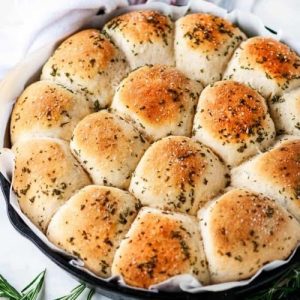
Fluffy Rosemary Garlic Dinner Rolls
Warm, soft, and aromatic, these Rosemary Garlic Dinner Rolls are perfect for pairing with soups, stews, or pasta dishes. Made with a simple blend of fresh rosemary, garlic, and basic pantry staples, they’re quick to prepare, golden-baked, and ideal for family dinners or meal prep.
Equipment
- 1 standing mixer with dough hook
- 1 small microwave-safe bowl
- 1 9x13-inch baking dish (or similar)
- Parchment Paper (for lining)
- Measuring Cups and Spoons
- Whisk
- Knife or pizza cutter
Ingredients
- ¾ cup water
- 1 tablespoon rapid rise instant yeast fast-acting
- 3 tablespoons sugar
- ½ cup milk 2% recommended
- 4 tablespoons unsalted butter plus extra for greasing
- 1 large egg beaten
- 1 ½ teaspoons salt
- 3 ½ –4 cups all-purpose unbleached flour
- 2 tablespoons fresh rosemary minced
- 3 garlic cloves minced
Instructions
- Prepare Oven and Pan: Preheat your oven to 400°F (200°C). Grease a 9x13-inch baking dish with butter or line it with parchment paper to prevent sticking. Lining with parchment ensures the rolls lift out easily and maintain their soft texture.
- Warm Liquid Ingredients: In a small microwave-safe bowl, combine ¾ cup water, 3 tablespoons sugar, 3 tablespoons butter, and ½ cup milk. Heat the mixture in the microwave for about 1 minute until it feels very warm to the touch, around 110–115°F. If it’s not warm enough, continue heating in 10–15 second increments, whisking each time, until the desired warmth is reached. The liquid should be warm enough to activate the yeast but not hot enough to kill it.
- Activate Yeast: Pour the warm liquid mixture into the bowl of a standing mixer fitted with a dough hook. Sprinkle 1 tablespoon of rapid rise instant yeast evenly over the liquid. Let it sit undisturbed for 5–7 minutes. The yeast will start to foam and bubble, signaling that it is active and ready to leaven the dough. A foamy surface is a key indicator of properly activated yeast.
- Combine Dry Ingredients and Herbs: Add 3 ½ cups of all-purpose flour, 1 ½ teaspoons salt, 1 tablespoon of minced rosemary, 3 minced garlic cloves, and the beaten egg to the yeast mixture. Start mixing on the lowest speed or “stir” setting for 1–2 minutes until the dough begins to come together.Tip: The dough should start pulling away from the sides of the bowl. If it’s still sticky, add extra flour ¼ cup at a time, mixing for an additional minute after each addition. Use no more than 4 cups total to ensure the rolls stay soft.
- Knead the Dough: Increase the mixer speed to medium-low and knead the dough for 5 minutes using the dough hook. Kneading develops gluten, which gives the rolls structure while keeping them fluffy. The dough should feel slightly sticky but elastic and smooth when pressed.
- First Rise: Grease a large bowl with butter. Transfer the kneaded dough into this bowl, turning to coat it lightly with butter to prevent sticking. Cover the bowl with plastic wrap or a clean kitchen towel and allow the dough to rise in a warm area for 20 minutes. During this time, the dough will expand slightly as the yeast ferments.
- Divide Dough Into Rolls: Once risen, gently turn the dough onto a lightly floured surface. Carefully punch it down to release excess air. Using a knife or pizza cutter, divide the dough into 15 equal portions. Shape each piece into a ball by folding the seams underneath and rolling gently between your palms for a smooth, tight surface.
- Arrange Rolls in Baking Dish: Place each shaped dough ball seam-side down in the prepared baking dish. Ensure there’s a little space between rolls for expansion but they can be close enough to touch slightly. Cover the dish loosely with plastic wrap and let the rolls rise again for another 20 minutes. This second rise ensures extra softness and a light, fluffy interior.
- Prepare Rosemary Butter Glaze: While the rolls are rising, melt the remaining 1 tablespoon of butter in a small saucepan or microwave-safe bowl. Stir in 1 tablespoon of minced rosemary to create a fragrant, golden glaze. This will be brushed on top of the rolls for extra flavor and a shiny, appetizing finish.
- Apply Glaze and Bake: Once the second rise is complete, gently brush each roll with the rosemary butter glaze. Be careful not to deflate them. Place the baking dish in the preheated oven and bake for 13–15 minutes, or until the rolls are golden brown on top and cooked through. The aroma of fresh garlic and rosemary should fill your kitchen.
- Cool and Serve: Remove the rolls from the oven and allow them to cool slightly in the dish for 5–10 minutes. Serve warm alongside soups, stews, roasted meats, or as a snack. The rolls are soft inside with a lightly crisp, golden top, making them perfect for everyday meals or special gatherings.
Notes
- Yeast Activation: Ensure your water and milk mixture is warm but not hot, around 110–115°F. Too hot and the yeast will die, too cold and it won’t activate properly.
- Flour Adjustment: Dough consistency may vary slightly depending on humidity and flour type. Start with 3 ½ cups and gradually add up to 4 cups if needed; the dough should be slightly sticky but elastic.
- Rolling Technique: Folding the seam underneath when shaping each roll ensures a smooth, rounded top and even baking.
- Second Rise Importance: Don’t skip the second rise; it makes the rolls exceptionally soft, airy, and light.